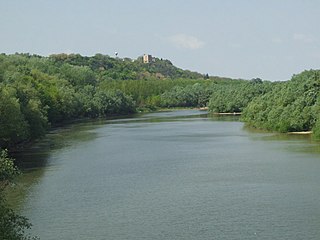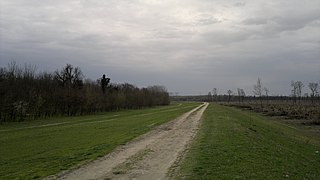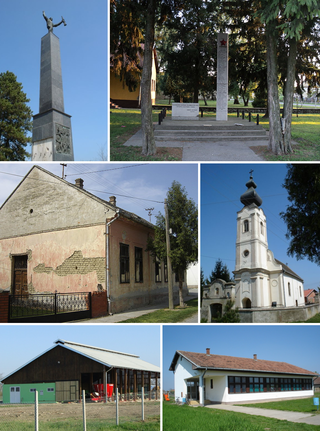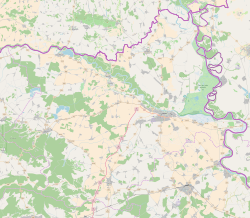
Bilje is a municipality in the Baranja region of Osijek-Baranja County, in north-eastern Croatia. It is 5 km northeast of Osijek, on the edge of the Kopački Rit nature park. Prince Eugene of Savoy (1663-1736) constructed a hunting lodge here, Bilje Castle, which later became property of the Teschen branch of the Habsburg family.

Erdut is a village and a municipality in eastern Croatia some 37 km east of the major city of Osijek. Lying on the border with neighbouring Serbia, it was the site of the signing of the 1995 Erdut Agreement, which initiated the UNTAES transitional administration over the Eastern Slavonia, Baranja and Western Syrmia.

Jagodnjak is a village and a municipality in the Osijek-Baranja County, Croatia. Landscape of the Jagodnjak Municipality is marked by the Drava river with surrounding wetland forest and by Pannonian Basin plains with agricultural fields of wheat, common sunflower, maize and sugar beet.

Ernestinovo is a municipality in Osijek-Baranja County, Croatia.
Magadenovac is a village and a municipality in Osijek-Baranja County, Croatia.
Punitovci is a municipality in Osijek-Baranja County, Croatia. There are a total of 1,803 inhabitants.

Vardarac is a settlement in the region of Baranja, Croatia. Administratively, it is located in the Bilje municipality within the Osijek-Baranja County. Population is 630 people.
Kamenac is a settlement in the region of Baranja, Croatia. Administratively, it is located in the Kneževi Vinogradi municipality within the Osijek-Baranja County. Population is 177 people.

Karanac is a settlement in the region of Baranja, Croatia. Administratively, it is located in the Kneževi Vinogradi municipality within the Osijek-Baranja County. Population is 1,065 people. Today, the village mainly lives on tourism. The place once belonged to the manor of Darda.
Kotlina is a settlement in the region of Baranja, Croatia. Administratively, it is located in the Kneževi Vinogradi municipality within the Osijek-Baranja County. The population is 334 people.

Suza is a settlement in the region of Baranja, Croatia. Administratively, it is located in the Kneževi Vinogradi municipality within the Osijek-Baranja County. Population is 636 people.

Bolman is a settlement in the region of Baranja, Croatia. Administratively, it is located in the Jagodnjak municipality within the Osijek-Baranja County. Population is 450 people.

Majške Međe is a settlement in the region of Baranja, Croatia. Administratively, it is located in the Jagodnjak municipality within the Osijek-Baranja County. Population is 82 people.
Novi Bolman is a settlement in the region of Baranja, Croatia. Administratively, it is located in the Jagodnjak municipality within the Osijek-Baranja County. Population is 122 people.

Palača, Hungarian: Palacsa) is a village in Osijek-Baranja County, Croatia. It is part of the Šodolovci municipality. The settlement was originally established as a pustara, a Pannonian type of hamlet.

Ada is a village in Šodolovci, Osijek-Baranja County, Croatia. The settlement was originally a pustara, a Pannonian type of hamlet.
Paulin Dvor is a village in the municipality of Šodolovci, eastern Croatia, population 76.
Koprivna is a village in Osijek-Baranja County, Croatia. It is part of the Šodolovci municipality and it has a population of 113.

Silaš is a village in the Šodolovci municipality in Osijek-Baranja County, Croatia. At the time of 2011 Census village's population was 476. Silaš was established in 1922 in the aftermath of the World War I on the spot of abandoned Eltz seigniory. Its original inhabitants were families of Serb soldiers who participated in the Salonica front battles against the German Empire, Austria-Hungary and Bulgaria.
Petrova Slatina is a village in Osijek-Baranja County, Croatia. It is part of the Šodolovci municipality and it has a population of 209.



















